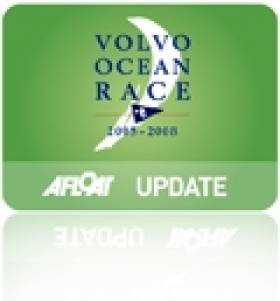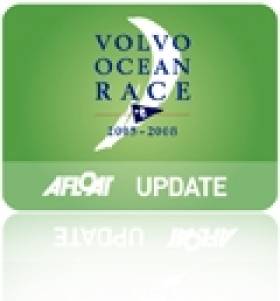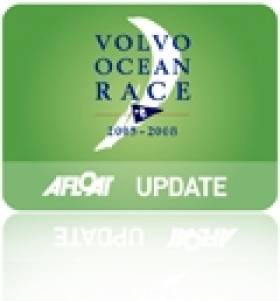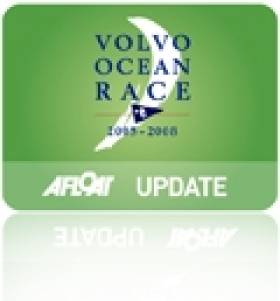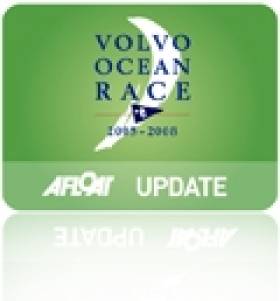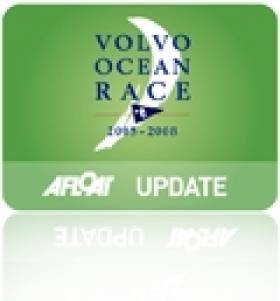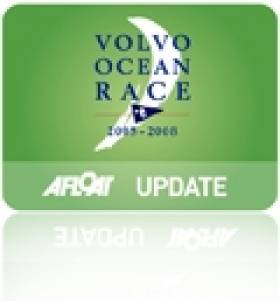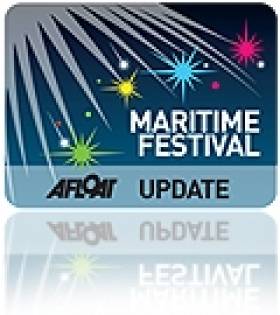Displaying items by tag: Volvo Ocean Race
Volvo Ocean Race One-Design Finally Hits The Water
#VOR - The new one design VOR 65 that will race the next edition of the Volvo Ocean Race has taken to the water for the first time - and as the video clip above shows, she's a sight to behold.
The VOR 65 is the first one-design yacht to compete in the Volvo Ocean Race, formerly the Whitbread Round the World Race, which has a history going back 40 years.
And according to the VOR website, more than 120 people put in 36,000 man hours across two continents to bring Farr Yacht Design's vision into reality.
More lithe than the 70-footers that ploughed the seas in the last edition of the VOR - which concluded in exciting fashion in Galway last year - the VOR 65 is nevertheless built to last.
Indeed, it's expected that the same yachts racing out of Alicante in October 2014 will be competing in the 13th edition of the race in 2017-18 as well.
This past Monday the first completed yacht of the fleet, already painted in the livery of Team SCA, hit the water for its pull-down test ahead of its first sailing out of Southampton.
But the bigger test is when the all-woman Team SCA sail their state-of-the-art yacht from England to their home base in Lanzarote.
"It's a very proud moment," commented Green Marine project manager Connell Daino at the boat's first moments afloat. "This represents a lot of hard work by a lot of people but really it's just a beginning. We have a long way to go."
VOR Teams Share Their Fastnet Race Experiences
#VOR - Abu Dhabi Ocean Racing are making their return in the next Volvo Ocean Race after a distinguished debut showing in 2012, with new racing director Neal McDonald at the helm.
But the Ian Walker-skippered squad are already training hard with more than a year to go - and the recent Fastnet Race served as the first proper test of their skills.
The video above details the crew's experiences racing across the Celtic Sea from Cowes to Fastnet Rock and back - and their engaging tussle with fellow VOR squad Team SCA, whose finish time just edges them ahead.
Speaking of Team SCA, the all-female team's skipper Liz Wardley shared her own thoughts during the challenging non-stop Fastnet round trip:
The VOR website has links to similar video diaries from crewmates Sophie Ciszek, Sam Davies, Carloijn Brouwer and Annie Lush.
In other recent VOR news, Swiss luxury watch manufacturer IWC Schaffhausen has signed a new deal as the race’s official timekeeper for 2014-15 – and will once again sponsor the prestigious IWC Schaffhausen 24-hour Speed Record Challenge.
And the new one design VOR 65 may make its first appearance on the water as a finished vessel as early as tomorrow (23 September) after a detailed seven-month build with key components produced in various parts of the world.
VOR's All-Woman Team Gets Two New Members
#VOR - The all-woman team competing in the next Volvo Ocean Race have taken on two new recruits in Brit sailor Abby Ehler and Aussie stalwart Stacey Jackson.
Ehler is a veteran of the VOR, sailing as a member of the last all-female team Amer Sports Too in 2001-2002, while Jackson was a candidate in the training trials earlier this year.
Both join an already record-breaking Team SCA squad that's set to make a big mark among the racing fleet come October 2014.
The new appointments now bring Team SCA's complement to seven, with four spots lets to fill, just over a year ahead of the first leg in the 12th running of the round-the-world yachting challenge.
In other VOR news, Cape Town in South Africa has been selected as the first stopover in next year's race after plans to visit Recife in Brazil were scuppered by the withdrawal of the local team from the competition.
“It is of course disappointing not to go to Recife in this edition but Brazil is very well represented in this race including a stop in Itajaí,” said Volvo Ocean Race CEO Knut Frostad.
Cape Town's waterfront is more than able to step in as a replacement, however, having hosted the race on 10 previous occasions.
New Tech To Revolutionise Sailing Stories In VOR
#VOR - The latest video update following the construction of the new one-design yacht debuting in next year's Volvo Ocean Race looks at the state-of-the-art technology that will be installed both on board and on shore to make the 12th running of the race the most connected yet.
Three VOR 65s are at Green Marine in Southampton at various stages of completion, awaiting the final detailed fittings before they can take to the water for their first sea trials.
Those fittings include the latest in communications technology that will hopefully combine the sailors' experiences - via self-shot smartphone video and on-deck camera positions - with the raw numbers from their boat's telemetry data to provide the most detailed stories yet.
The on-shore media centre, too, will be fully connected to all the action via specially outfitted workstations that will let journalists write, edit and transmit from the one spot.
McDonald is Abu Dhabi's VOR Racing Director
#vor – sailing veteran and British Olympian Neal McDonald, is to taking the helm as Abu Dhabi Ocean Racing's Performance Director in the team's second bid for Volvo Ocean Race glory next year. Emirati star, 24-year-old Adil Khalid, has re-signed as an Abu Dhabi Ocean Racing crew member under the leadership of skipper Ian Walker.
Six-time Volvo Ocean Race legend McDonald, from Brighton in the UK, has completed more than 200,000 nautical miles in the race over a nearly two decade long offshore career. Alongside Walker, he will lead Abu Dhabi Ocean Racing's technical programmes, training camps and crew development to streamline the team's victory pursuit in the 2014-15 Volvo Ocean Race, starting next October in Alicante, Spain.
"Neal is one of our generation's best sailors and will bring a fresh, winning dynamic to the team's preparation. Having played an instrumental part in a hat-trick of leg 1, 2 and 3 victories for Team Telefonica in the previous race, his broad depth and diversity of experience and knowledge will be critical in our next campaign," said Walker.
"As a qualified naval architect he is extremely analytical and capable on the technical side. I have the upmost respect for Neal and he would always be my first choice on any team sheet. I can't think of a better person to inspire our team for the challenges that lie ahead.
"With the advent of one-design boats the emphasis will be much more on the sailors and I hope that Neal will help us create the strongest team possible," added Walker, himself a two-time Volvo Ocean Race and America's Cup veteran.
Meanwhile, Adil Khalid, who during the last race became the first Arab sailor to compete in and complete the global event, joins the team this week in the UK for his competitive Abu Dhabi Ocean Racing return, taking part in the Aberdeen Asset Management Cowes Week's Big Boat Races (6-8th August) before crewing the team's defence of its Rolex Fastnet Race record next week (11-13th August).
And Walker, who mentored the young Emirati Olympian during the 2011-12 campaign, said Khalid's experience will serve the team well as it again prepares for a title tilt.
"Adil earned everybody's respect on board in the last race. He now has all that experience and with hard work he should grow into a senior team member. Adil is a very patriotic young man and a great role model for all young sailors in Abu Dhabi, the United Arab Emirates and the entire Arabian Gulf region. I am sure he will get to wave the UAE flag many more times during the next race," said Walker.
Joining his fellow countryman, 27-year-old Butti Al Muhairi, also returns to Abu Dhabi Ocean Racing, on the shore team, after a successful stint in the previous race. Al Muhairi, Khalid's reserve, will guide a core group of young Emiratis working across the shore-side operations.
Al Muhairi will be led by America's Cup and Volvo Ocean Race specialist, Guy Barron, who joins as Abu Dhabi Ocean Racing's Shore Manager. With more than 25 years professional sailing under his belt, Barron will use his vast experience to optimise all shore-side operations throughout the 39,000 mile global event.
Abu Dhabi Ocean Racing will announce its full crew line-up in the first quarter of 2014, when it will also receive its new one-design Volvo 65 race yacht.Abu Dhabi city, the UAE capital, will host the third 2014-15 Volvo Ocean Race stopover from mid-December 2014 until 3rd January 2015.
Abu Dhabi will welcome the fleet from Recife, Brazil after one of the longest and potentially most-gruelling legs in the 40-year race history (9,707 nautical miles). The Abu Dhabi Etihad Airways In-Port Race, which was won by home favourites Abu Dhabi Ocean Racing in the last edition, will take place on January 2nd 2015, with the fleet departing for Sanya, China the following day.
VOR 65 On The 'Leading Edge' Of Racing Yacht Design
#VOR - Seahorse Magazine takes an in-depth look at Farr Yacht Design's work on the appendages for the new one design VOR 65 that will compete in the next edition of the Volvo Ocean Race next year.
Farr designer Alon Finkelstein goes step-by-step through the different key elements that attach to the hull, from the keel to the bulb, daggerboard and rudder - the parts that can make or break a racing yacht.
"The design brief... required the appendage package to be significantly less costly than that of a Volvo Open 70, with equivalent or higher safety factors... and a similar performance envelope," he writes.
But boat designers constantly strive to achieve more for less, and as Finkelstein explains, the design of the VOR 65 is no different.
Seahorse Magazine has much more on the story HERE.
VOR Women Smash Racing Records Off Lanzarote
#VOR - Team SCA have been posting some record-breaking times in their training runs off Lanzarote as of late, as the official Volvo Ocean Race website reports.
Most recently the all-female team set a new record from Puerto Calero to La Palma Marina last weekend. This achievement followed their victory in the Round Lanzarote Race last month - their first competitive event sailing together as a team.
"It was a fairly big milestone in our preparations and we were lucky to have great conditions, which enabled us to get the race record," said Vendee Glone veteran Sam Davies, who captains a squad of world-class racing women eager to jump into their next challenge - the Rolex Fastnet Race in August.
Meanwhile, the Volvo Ocean Race is currently celebrating its 40th anniversary, and put together the short film above "about the spirit and the people behind sport's ultimate test of character".
The heat is already on for the return of the race in October next year, with the new design VOR 65 coming together nicely.
In the latest video update following the new yacht's construction, VOR's Rick Deppe visits the Gottifredi Maffioli factory in Italy where the ropes are being made:
#Tourism - The world-class surfing hotspot of Sligo has failed to make the grade in Fáilte Ireland's long list of leading tourism towns for 2013, according to the Irish Independent.
The north-east county was among a surprise selection of areas known for their maritime and waterways attractions - such as Westmeath on the Shannon and Galway, host of last year's Volvo Ocean Race finale - that were not featured in the Irish tourism board's list of 45 towns and villages put forward for the Highly Commended Tourism Towns award, part of the National Tidy Towns Awards to be announced later in the year.
Counties on the water that did make the cut include Clare and Mayo, with five towns each on the list, Kerry with four - including last year's winner Portmagee - and Donegal and Waterford, represented three times each.
The top prize winner, to be announced by Fáilte Ireland in November, will receive €10,000 in supports for tourism marketing and development.
Though Sligo is conspicuous by its absence, Donegal's triple placing shows the north-east region is a big tourism attraction - and the Tripclocker blog says surfing is at the forefront of that.
With Ireland's exposure to the open Atlantic giving is "better waves more often", according to Killian O'Kelly of Bundoran's Turn n' Surf, there is a wide variety of surf beaches stretching from Donegal to Clare in particular with swells for all levels of experience.
VOR Sail Wardrobe For New One Design Unveiled
#VOR - North Sails has revealed its sail wardrobe for the new one design VOR 65 with less than 18 months to go before the latest Volvo Ocean Race sets sail.
As The Daily Sail reports, the sails will be manufactured at North Sails' Nevada base using its 3Di process in a range of deniers, except for the A3 and storm jib.
Sails will be constructed in batches to ensure the same mould is used for eight sails of one type. The sails will then be finished at Vannes in France before being paired up with their respective vessels, assembly of which is racing ahead.
Perhaps most importantly, each team competing will have the use of just 12 sails - only eight of which will be allowed on board for each leg of the race. No recuts will be allowed except for repairs, in order to maintain the fairness of the one design principle.
“Our main objective is to make a really durable sail that holds its shape and stays together for as long as the race needs it to stay together," said North Sails general manager Jeff Neri.
The Daily Sail has more on the story HERE.
Galway Expects Crowds For First Sea Festival
#Festivals - "Tens of thousands" of visitors are expected to flock to the City of the Tribes later this month for the first Galway Sea Festival over the June bank holiday weekend, according to the Galway Advertiser.
Dubbed the 'Mini-Volvo' by locals, the four-day event from 31 May till 3 June is hoped to recreate the celebratory atmosphere of last summer's successful Volvo Ocean Race finale, with a wide range of events both on and off the waters of Galway Bay.
Highlights include the festival regatta led by the Galway Bay Sailing Club's parades of sail on the Friday and Saturday evenings, and a traditional boat regatta by Badoiri na Cladaigh.
Watersports enthusiasts can get a taste of canoeing, diving, sea kayaking and windsurfing over the weekend, which also coincides with World Oceans Day - with family-friendly activities at the Galway Atlantaquaria on Sunday 2 June - and the International Canoe Polo Championships at Claddagh Basin.
Preceding the festival on Thursday 30 May will be the Bright Blue Sea Conference, a major international symposium on marine science, renewable energy, the environment and the 'blue economy'.
Last month it was reported that the Galway Sea Festival received the financial backing of Galway City Council, spurred by its aims to promote Galway as a maritime destination or commerce and tourism.
The Galway Advertiser has much more on the festival HERE.




























